Implementasi IoT dalam Otomasi Pengontrolan Kondisi Lingkungan dan Pemberian Pakan: Efeknya Terhadap Parameter Efisiensi Peternakan
DOI:
https://doi.org/10.32493/informatika.v6i2.7474Keywords:
Feed Conversion Ratio, feed intake, mortality rate, effective Internet of Things, smart poultryAbstract
Nowday 35% of Indonesians buy poultry products every week. However, 95% of Indonesia farms are small open houses often built from bamboo using manual feeding and watering systems. The problem related to the manual feeding and watering system is the high mortality rate of poultry, which is an average of 8%. The use of IoT (Internet of Things) in agriculture and livestock is increasingly popular. This research implemented IoT on a poultry farm to automatically control environmental conditions based on sensor readings and measure feed level and water consumption. It also monitored chicken weight via a digital scale. This study also measured the farm efficiency parameters before and after IoT implementation, namely FCR, IP, and mortality rates. The results showed that the performance of IoT in poultry farms could increase efficiency. After IoT implementation, the FCR value decreased from 1.46 to 1.38, which led to an increase in the FE value to 72%. The IP score increased to 391.1. The mortality rate of chickens decreased from 3.67% to 2.35%. Also, the average weight of chickens at harvest is 1460gr. the mortality rate of chickens decreased from 3.67% to 2.35%. Also, the average weight of chickens at harvest is 1460gr.
References
Adhistian, P. (2019). Analisis Pengukuran Jarak Perangkat-Sensos pada Implementasi Sensor dengan Arduino Smart Home Solution. Teknologi: Jurnal Ilmiah dan Teknologi, 1(2), 124-126.
Alonzo, A. (2016). Foreign ?rms dominate Indonesian broiler production, “Poultry Internationalâ€, Oktober, pp. 24-27
Gao Guandong, Jia Yuchen, Xiao Ke. 2017. “An IOT-based Multi-sensor Ecological Shared Farmland Management Systemâ€, International Journal of Online Engineering, vol 14, no. 03.
Handigolkar, L. S., Kavya, M. L., & Veena, P. D. (2016). Iot based smart poultry farming using commodity hardware and software. Bonfring International Journal of Software Engineering and Soft Computing, 6(Special Issue), 171-175.
Indonesian Feed Producers Association (APPI). (2015). Industri peternakan Indonesia adalah sektor utama bagi perekonomian nasional, “Environment and Planning A: Economy and Spaceâ€, 23 September, http://www.seekingalpha.com, pp. 1-17.
Kumar, C. K., Ibrahim, M. M., Srikanth, N. M., Aswin, S., & Peeyush, K. P. (2017, September). Internet of things based approach for open precision farming. In 2017 International Conference on Advances in Computing, Communications and Informatics (ICACCI) (pp. 2225-2230). IEEE.
Mansor, H., Azlin, A. N., Gunawan, T. S., Kamal, M. M., & Hashim, A. Z. (2018). Development of smart chicken poultry farm. Indonesian Journal of Electrical Engineering and Computer Science, 10(2), 498-505.
Prakash, A., Saxena, V.K. and Singh, M.K., (2020). Genetic analysis of residual feed intake, feed conversion ratio and related growth parameters in broiler chicken: a review. World's Poultry Science Journal, pp.1-14.
Purnomo, H. D., Saputro, D. A., Somya, R., & Fibriani, C. (2017). The Application of Restful Web Service and JSON for Poultry Farm Monitoring System. Journal Of Electrical Engineering And Computer Sciences, Vol 1 Number 1, June 2016, 1(1).
Sell-Kubiak, E., Wimmers, K., Reyer, H. and Szwaczkowski, T., (2017). Genetic aspects of feed efficiency and reduction of environmental footprint in broilers: a review. Journal of applied genetics, 58(4), pp.487-498.
Downloads
Published
Issue
Section
License
Authors who publish with this journal agree to the following terms:
- Authors retain copyright and grant the journal right of first publication with the work simultaneously licensed under a Creative Commons Attribution-NonCommercial 4.0 International (CC BY-NC 4.0) that allows others to share the work with an acknowledgement of the work's authorship and initial publication in this journal.
- Authors are able to enter into separate, additional contractual arrangements for the non-exclusive distribution of the journal's published version of the work (e.g., post it to an institutional repository or publish it in a book), with an acknowledgement of its initial publication in this journal.
- Authors are permitted and encouraged to post their work online (e.g., in institutional repositories or on their website) prior to and during the submission process, as it can lead to productive exchanges, as well as earlier and greater citation of published work (See The Effect of Open Access).
Jurnal Informatika Universitas Pamulang have CC-BY-NC or an equivalent license as the optimal license for the publication, distribution, use, and reuse of scholarly work.
In developing strategy and setting priorities, Jurnal Informatika Universitas Pamulang recognize that free access is better than priced access, libre access is better than free access, and libre under CC-BY-NC or the equivalent is better than libre under more restrictive open licenses. We should achieve what we can when we can. We should not delay achieving free in order to achieve libre, and we should not stop with free when we can achieve libre.
Jurnal Informatika Universitas Pamulang is licensed under a Creative Commons Attribution-NonCommercial 4.0 International (CC BY-NC 4.0)
YOU ARE FREE TO:
- Share : copy and redistribute the material in any medium or format
- Adapt : remix, transform, and build upon the material for any purpose, even commercially.
- The licensor cannot revoke these freedoms as long as you follow the license terms





